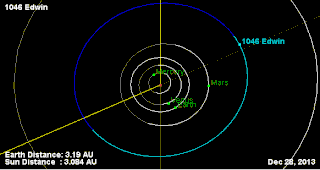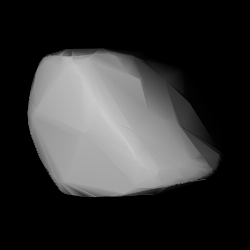Related Research Articles

834 Burnhamia is a large background asteroid, approximately 61 kilometers in diameter, that is located in the outer region of the asteroid belt. It was discovered on 20 September 1916, by German astronomer Max Wolf at the Heidelberg Observatory in southwest Germany. The X-type asteroid (GS) has a rotation period of 13.9 hours. It was named after American astronomer Sherburne Wesley Burnham (1838–1921).
985 Rosina, provisional designation 1922 MO, is a stony asteroid and sizable Mars-crosser on an eccentric orbit from the inner regions of the asteroid belt, approximately 8 kilometers in diameter. It was discovered on 14 October 1922, by astronomer Karl Reinmuth at the Heidelberg-Königstuhl State Observatory in Germany. The asteroid's name is a common German female name, unrelated to the discoverer's contemporaries.
993 Moultona, provisional designation 1923 NJ, is a Koronian asteroid from the outer regions of the asteroid belt, approximately 14 kilometers in diameter. It was discovered on 12 January 1923, by astronomer George Van Biesbroeck at the Yerkes Observatory in Williams Bay, Wisconsin, in the United States. The likely elongated asteroid has a rotation period of 5.3 hours. It was named after American astronomer Forest Ray Moulton.
8992 Magnanimity, provisional designation 1980 TE7, is a stony asteroid from the inner regions of the asteroid belt, approximately 6 kilometers in diameter.
1024 Hale, provisional designation A923 YO13, is a carbonaceous background asteroid from the outer regions of the asteroid belt, approximately 45 kilometers (28 miles) in diameter. The asteroid was discovered on 2 December 1923, by Belgian–American astronomer George Van Biesbroeck at the Yerkes Observatory in Wisconsin, United States. It was named for American astronomer George Ellery Hale. The dark C-type asteroid may have a rotation period of 16 hours.
1033 Simona, provisional designation 1924 SM, is a stony Eoan asteroid from the outer regions of the asteroid belt, approximately 20 kilometers in diameter. The asteroid was discovered by George Van Biesbroeck in 1924, who named it after his daughter Simona.

1046 Edwin, provisional designation 1924 UA, is a background asteroid from the outer regions of the asteroid belt, approximately 30 kilometers kilometers in diameter. It was discovered on 1 December 1924, by Belgian–American astronomer George Van Biesbroeck at the Yerkes Observatory in Wisconsin, United States, who named it after his son, Edwin Van Biesbroeck. The potentially metallic asteroid has a short rotation period of 5.29 hours.

1058 Grubba, provisional designation 1925 MA, is a stony Flora asteroid from the inner regions of the asteroid belt. It was discovered on 22 June 1925, by Soviet–Russian astronomer Grigory Shajn at the Simeiz Observatory on the Crimean peninsula. The S-type asteroid was named for Irish telescope maker Howard Grubb. It has a longer-than average rotation period of 46.30 hours and measures approximately 12 kilometers in diameter.
1079 Mimosa, provisional designation 1927 AD, is a stony Karin or Koronian asteroid from the outer regions of the asteroid belt, approximately 20 kilometers in diameter. It was discovered on 14 January 1927, by Belgian–American astronomer George Van Biesbroeck at the Yerkes Observatory in Williams Bay, Wisconsin. The asteroid was named after the flowering plant Mimosa.
3673 Levy, provisional designation 1985 QS, is a binary Flora asteroid from the inner regions of the asteroid belt, approximately 6 kilometers in diameter. It was discovered on 22 August 1985, by American astronomer Edward Bowell at Lowell's Anderson Mesa Station near Flagstaff, Arizona, United States. The asteroid was named after Canadian astronomer David H. Levy.
3988 Huma, provisional designation 1986 LA, is an eccentric sub-kilometer asteroid and near-Earth object of the Amor group. It was discovered on 4 June 1986, by American astronomer Eleanor Helin at Palomar Observatory, California. The asteroid measures approximately 700 to 800 meters in diameter and was named after the Huma bird from Iranian mythology.
1213 Algeria is a carbonaceous asteroid from the outer region of the asteroid belt, approximately 32 kilometers in diameter. Discovered by Guy Reiss at Algiers Observatory in 1931, it was named after the North African country of Algeria.
2744 Birgitta, provisional designation 1975 RB, is a stony asteroid and a Mars-crosser on an eccentric orbit from the innermost regions of the asteroid belt, approximately 3 kilometers in diameter. It was discovered at the Kvistaberg Station of the Uppsala Observatory in Sweden on 4 September 1975, by Swedish astronomer Claes-Ingvar Lagerkvist, who named it after his daughter, Anna Birgitta Angelica Lagerkvist. The S-type asteroid has a rotation period of 9.0 hours.
24101 Cassini (provisional designation 1999 VA9) is an eccentric background asteroid from the middle region of the asteroid belt, approximately 7 kilometers in diameter. It was discovered on 9 November 1999, by American amateur astronomer Charles Juels at the Fountain Hills Observatory (678) in Arizona, United States. It was named after Italian–French astronomer Giovanni Cassini.

1804 Chebotarev is a stony background asteroid from the inner regions of the asteroid belt, approximately 10 kilometers in diameter. It was discovered on 6 April 1967, by Russian astronomer Tamara Smirnova at the Crimean Astrophysical Observatory in Nauchnyj on the Crimean peninsula. The asteroid was named after Soviet astronomer G. A. Chebotarev.
1951 Lick, provisional designation 1949 OA, is a rare-type asteroid and Mars-crosser, approximately 5.6 kilometers in diameter. It was discovered on 26 July 1949, by American astronomer Carl Wirtanen at Lick Observatory on the summit of Mount Hamilton, California, and named for American philanthropist James Lick.

1781 Van Biesbroeck is a Vesta asteroid from the inner regions of the asteroid belt, approximately 8.5 kilometers in diameter. It was discovered on 17 October 1906, by German astronomer August Kopff at Heidelberg Observatory in southern Germany. It was named after astronomer George Van Biesbroeck.

1312 Vassar, provisional designation 1933 OT, is a carbonaceous Alauda asteroid from the outer region of the asteroid belt, approximately 30 kilometers in diameter. It was discovered on 27 July 1933, by Belgian–American astronomer George Van Biesbroeck at Yerkes Observatory in Wisconsin, United States. The asteroid was named for the American Vassar College.
4324 Bickel, provisional designation 1981 YA1, is a stony asteroid from the middle region of the asteroid belt, approximately 12 kilometers in diameter. It was discovered on 24 December 1981, by American astronomer Laurence Taff at Lincoln Laboratory's Experimental Test Site in Socorro, New Mexico, United States. The asteroid was named after amateur astronomer Wolf Bickel.
(15700) 1987 QD is a Mars-crossing asteroid and a binary candidate from inside the innermost region of the asteroid belt, approximately 3 kilometers in diameter. It was discovered on 24 August 1987, by American astronomer Stephen Singer-Brewster at the Palomar Observatory in California. The likely spherical X-type asteroid has a rotation period of 3.1 hours. The suspected presence of a kilometer-sized minor-planet moon was announced in November 2000.
References
- 1 2 3 4 5 6 7 "JPL Small-Body Database Browser: 2253 Espinette (1932 PB)" (2017-04-28 last obs.). Jet Propulsion Laboratory . Retrieved 12 June 2017.
- 1 2 3 Schmadel, Lutz D. (2007). "(2253) Espinette". Dictionary of Minor Planet Names – (2253) Espinette. Springer Berlin Heidelberg. p. 183. doi:10.1007/978-3-540-29925-7_2254. ISBN 978-3-540-00238-3.
- 1 2 3 "2253 Espinette (1932 PB)". Minor Planet Center. Retrieved 19 May 2016.
- 1 2 3 4 5 "LCDB Data for (2253) Espinette". Asteroid Lightcurve Database (LCDB). Retrieved 19 May 2016.
- 1 2 3 Wisniewski, W. Z.; Michalowski, T. M.; Harris, A. W.; McMillan, R. S. (March 1995). "Photoelectric Observations of 125 Asteroids". Abstracts of the Lunar and Planetary Science Conference. 26: 1511. Bibcode:1995LPI....26.1511W . Retrieved 19 May 2016.
- 1 2 Behrend, Raoul. "Asteroids and comets rotation curves – (2253) Espinette". Geneva Observatory . Retrieved 19 May 2016.
- 1 2 Stephens, Robert D. (January 2016). "Asteroids Observed from CS3: 2015 July - September". The Minor Planet Bulletin. 43 (1): 52–56. Bibcode:2016MPBu...43...52S. ISSN 1052-8091 . Retrieved 19 May 2016.
- ↑ Pravec, Petr; Harris, Alan W.; Kusnirák, Peter; Galád, Adrián; Hornoch, Kamil (September 2012). "Absolute magnitudes of asteroids and a revision of asteroid albedo estimates from WISE thermal observations". Icarus. 221 (1): 365–387. Bibcode:2012Icar..221..365P. doi:10.1016/j.icarus.2012.07.026 . Retrieved 19 May 2016.
- ↑ Veres, Peter; Jedicke, Robert; Fitzsimmons, Alan; Denneau, Larry; Granvik, Mikael; Bolin, Bryce; et al. (November 2015). "Absolute magnitudes and slope parameters for 250,000 asteroids observed by Pan-STARRS PS1 - Preliminary results". Icarus. 261: 34–47. arXiv: 1506.00762 . Bibcode:2015Icar..261...34V. doi:10.1016/j.icarus.2015.08.007 . Retrieved 19 May 2016.
- ↑ "MPC/MPO/MPS Archive". Minor Planet Center. Retrieved 19 May 2016.